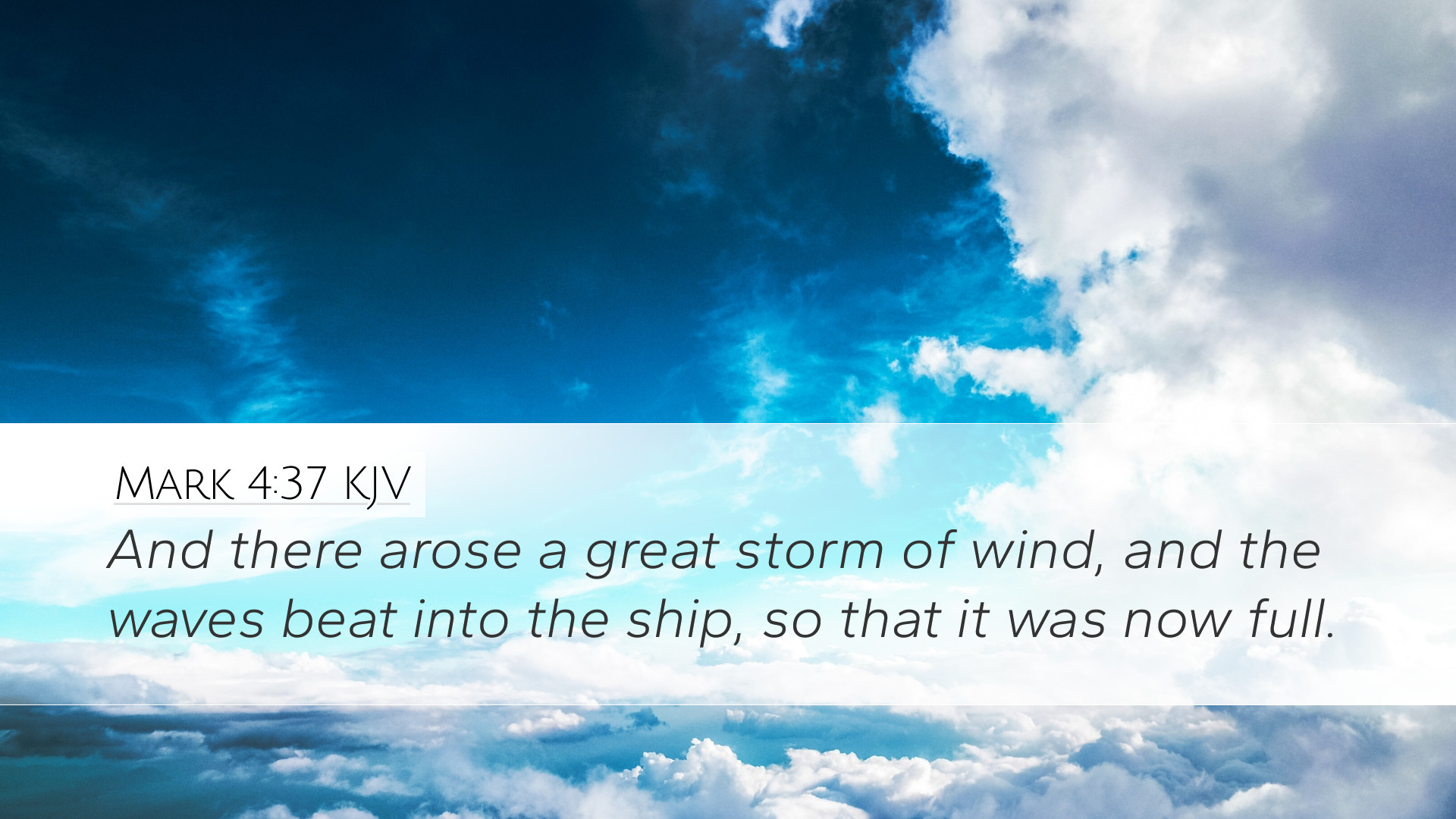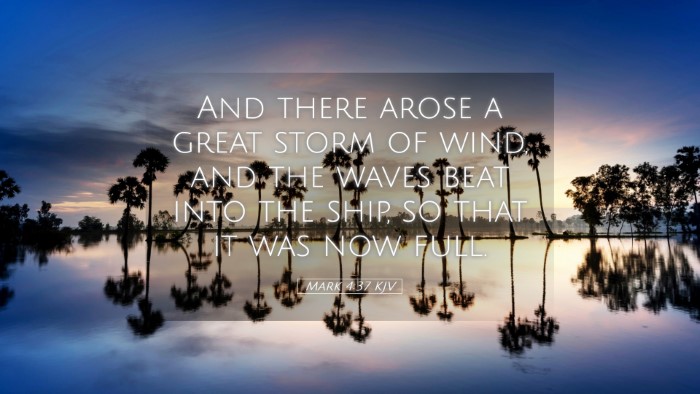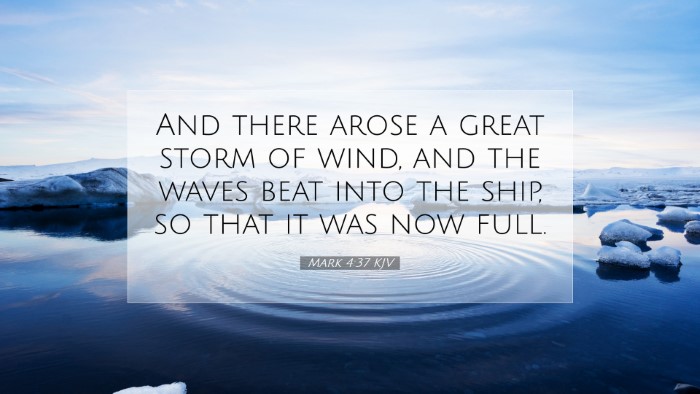Commentary on Mark 4:37
Verse Text: "And there arose a great storm of wind, and the waves beat into the ship, so that it was now full."
Introduction
Mark 4:37 depicts a scenario of profound distress as the disciples find themselves in the throes of a violent tempest during their journey across the Sea of Galilee. This verse sets the stage for understanding not only the physical challenge faced by the disciples but also the deeper spiritual lessons at play. The commentaries of Matthew Henry, Albert Barnes, and Adam Clarke provide rich insights into the nature of the storm, the disciples’ fear, and Christ’s mastery over chaos.
Overview of the Context
Before delving into the verse itself, it is beneficial to consider the surrounding context of Mark 4. Jesus has been teaching the crowds, employing parables to convey profound truths about the Kingdom of God. After these teachings, He instructs His disciples to cross to the other side of the sea. This journey becomes a crucial element in understanding the trials faced and the divine authority of Christ displayed during the storm.
Analysis of Key Elements
The Storm
The phrase “a great storm of wind” (KJV) captures the sudden and severe nature of the tempest. Matthew Henry comments that such storms were common on the Sea of Galilee, which was known for its susceptible geography—surrounded by hills that would funnel winds down into the water:
- Unexpectedness: The suddenness of the storm symbolizes the unexpected trials that believers may face.
- Intensity: The intensity (“great storm”) highlights the overwhelming challenges that can arise in life, resonating with the human experience of fear and vulnerability.
The Ship's Condition
According to Albert Barnes, the disciples’ ship was “now full” of water, illustrating both a literal struggle and a spiritual metaphor for being overwhelmed. The ship in peril serves as a sign of discipleship and the challenges faced in following Christ:
- Symbol of Faith: The ship can represent the believer’s life, which can be filled with troubles but is ultimately under Christ’s care.
- Community in Struggle: The presence of multiple disciples underscores collective struggles within the Christian community.
The Disciples' Fear
The disciples’ fear in this situation is palpable. Adam Clarke explains that their fear contrasts directly with their understanding of who Jesus is. Despite having witnessed His miracles, they are still gripped by terror in the midst of the storm:
- Human Response: Clarke emphasizes that fear is a natural response when confronted with danger. It reminds believers of their frailty.
- Challenge of Faith: The disciples’ fear signifies a moment of trial where faith is tested against the reality of their circumstances.
Christ's Presence
Importantly, Christ is present with the disciples in the storm, asleep in the ship. Matthew Henry notes that His calmness under duress reflects profound trust in God’s providence, serving as a model for believers:
- Peace in Chaos: Christ's sleep symbolizes perfect peace amidst turmoil, an invitation for believers to anchor themselves in faith.
- Divine Awareness: His awareness—despite appearing uninvolved—demonstrates that God is present in our struggles, even when He seems silent.
The Response to the Crisis
The disciples’ cry for help is both desperate and revealing. They call upon Jesus, indicating their recognition of His power even amid their doubt:
- Cry for Help: They cry out, "Teacher, do you not care that we are perishing?" This highlights an essential aspect of human nature— the innate desire for divine intervention in crises.
- Faith Within Fear: Their cry reflects a flickering flame of faith, wherein they realize that Jesus is their only source of hope. Clarke also notes that this cry serves as a reminder for believers to reach out to God in times of distress.
Theological Reflections
This verse and its surrounding context invite deeper theological reflection on God’s sovereignty, human frailty, and the nature of faith.
Sovereignty of God
The incident reinforces the sovereignty of Christ over nature, suggesting that nothing can thwart His plans, emphasizing His divine authority. As Barnes notes, the power of Jesus to command the storm and restore calm illustrates that He has power over all Creation.
Faith and Doubt
Discipleship is often marked by contradictions of faith and doubt. The relationship between fear and faith is pivotal in a believer's journey. The chaotic elements serve as a backdrop for understanding the necessity of trust in Jesus despite visible circumstances that provoke anxiety.
Christian Life as a Journey
Like the disciples, believers often find themselves in tumultuous circumstances on their journey of faith. This passage serves as a reminder that challenges do not mean abandonment by God but rather an opportunity to witness His power and presence in profound ways.
Conclusion
Mark 4:37 encapsulates the essence of a believer's experience: the reality of storms and the assurance of Christ's presence within them. As elaborated in the commentaries of Henry, Barnes, and Clarke, this passage offers rich truths about God’s control over nature, the validity of human fear, and the call to unwavering faith amid life's tempests. The intentional interplay between fear and faith encourages believers to look upon Christ, who is able to speak peace into the storms of our lives.


